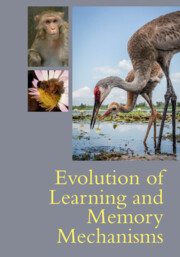Book contents
- Evolution of Learning and Memory Mechanisms
- Evolution of Learning and Memory Mechanisms
- Copyright page
- Contents
- Figures
- Tables
- Contributors
- Preface
- Introduction
- Part I Evolution of Learning Processes
- 1 Learning and Memory in the Nematode Caenorhabditis elegans
- 2 Adaptive Evolution of Learning and Memory in a Model Lineage
- 3 Learning in Insects: Perspectives and Possibilities
- 4 Experimental Evolution and Mechanisms for Prepared Learning
- 5 Evolutionary Processes Shaping Learning Ability in Insects
- 6 Brain and Spatial Cognition in Amphibians
- 7 Pavlovian Conditioning, Survival, and Reproductive Success
- 8 Compensatory Responses to Wildlife Control
- 9 Relational Memory Functions of the Hippocampal Pallium in Teleost Fish
- 10 Mechanisms Underlying Absolute and Relative Reward Value in Vertebrates
- 11 The Optimality of “Suboptimal” Choice
- 12 A Behavior Systems Framework
- 13 Dissociable Learning Processes
- 14 Social Learning Strategies
- 15 How Learning Affects Evolution
- Part II Evolution of Memory Processes
- Index
- References
2 - Adaptive Evolution of Learning and Memory in a Model Lineage
from Part I - Evolution of Learning Processes
Published online by Cambridge University Press: 26 May 2022
- Evolution of Learning and Memory Mechanisms
- Evolution of Learning and Memory Mechanisms
- Copyright page
- Contents
- Figures
- Tables
- Contributors
- Preface
- Introduction
- Part I Evolution of Learning Processes
- 1 Learning and Memory in the Nematode Caenorhabditis elegans
- 2 Adaptive Evolution of Learning and Memory in a Model Lineage
- 3 Learning in Insects: Perspectives and Possibilities
- 4 Experimental Evolution and Mechanisms for Prepared Learning
- 5 Evolutionary Processes Shaping Learning Ability in Insects
- 6 Brain and Spatial Cognition in Amphibians
- 7 Pavlovian Conditioning, Survival, and Reproductive Success
- 8 Compensatory Responses to Wildlife Control
- 9 Relational Memory Functions of the Hippocampal Pallium in Teleost Fish
- 10 Mechanisms Underlying Absolute and Relative Reward Value in Vertebrates
- 11 The Optimality of “Suboptimal” Choice
- 12 A Behavior Systems Framework
- 13 Dissociable Learning Processes
- 14 Social Learning Strategies
- 15 How Learning Affects Evolution
- Part II Evolution of Memory Processes
- Index
- References
Summary
Although reductionistic studies of mechanisms of learning in a broad range of model species have advanced our understanding of neural mechanisms, our integrated understanding of mechanisms, behavior, ecology, and evolution of learning remains patchy. A more wholistic research approach in a model lineage of species related to the sea hare, Aplysia californica, has revealed a complete loss of mechanisms of sensitization in one sea-hare genus, Dolabrifera, with concomitant changes in its behavior and ecology. A partial loss of sensitization via different mechanisms in a sister genus, Phyllaplysia, provides further information for our evolving understanding of the evolution of learning and memory. Does a relatively specific “change in diet” hypothesis, or a more universal “generalist versus specialist” hypothesis better predict the patterns? Further analyses of sensitization in a half-dozen additional sea-hare genera will distinguish the predictive powers of these and other synthetic evolutionary theories.
- Type
- Chapter
- Information
- Evolution of Learning and Memory Mechanisms , pp. 33 - 51Publisher: Cambridge University PressPrint publication year: 2022
References
- 1
- Cited by



